Chow Chow
The Chow-Chow is a dog breed originally from northern China,[3] where it is referred to as Songshi-Quan (Pinyin: sōng-shī quǎn), which translates to "puffy-lion dog".
| Chow-Chow | |||||||||||||||||||||||||||||||
|---|---|---|---|---|---|---|---|---|---|---|---|---|---|---|---|---|---|---|---|---|---|---|---|---|---|---|---|---|---|---|---|
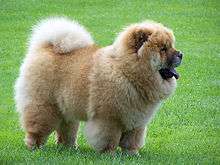 A cinnamon Chow-Chow puppy | |||||||||||||||||||||||||||||||
| Other names | Chow | ||||||||||||||||||||||||||||||
| Origin | China | ||||||||||||||||||||||||||||||
| |||||||||||||||||||||||||||||||
| |||||||||||||||||||||||||||||||
| Dog (domestic dog) | |||||||||||||||||||||||||||||||
History
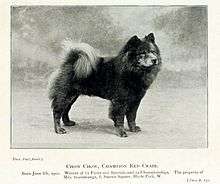

The Chow-Chow has been identified as a basal breed that predates the emergence of the modern breeds in the 19th Century.[4] One writer proposed that the Chow-Chow originated in China 2,000 years ago or possibly originated in Arctic Asia 3,000 years ago and then migrated to Mongolia, Siberia, then to China.[1]:11
One Chinese legend mentions large war dogs from Central Asia that resembled black-tongued lions. One Chinese ruler was said to own 5,000 Chows. The Chinese also used Chows to pull dog-sleds, and this was remarked upon by Marco Polo.[1]:11 One author states that the Chow-Chow was also bred for human consumption.[5]
Today, the American Kennel Club registers approximately 10,000 Chow-Chows a year. The Canadian Kennel Club registers approximately 350.[1]:4–5
Appearance
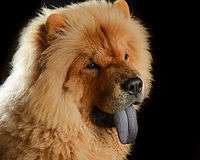
The Chow-Chow is a sturdily built dog, square in profile, with a broad skull and small, triangular, erect ears with rounded tips. The breed is known for a very dense double coat that is either smooth or rough.[1]:4–5 The fur is particularly thick in the neck area, giving it a distinctive ruff or mane appearance. The coat may be shaded/self-red, black, blue, cinnamon/fawn, or cream.[1]:4–5[6] Not all these color varieties are recognized as valid in all countries. Individuals with patchy or multicolored coats are considered to be outside the breed standard. Chow-Chow eyes are typically deep set and almond shaped. The breed is unique by their purple/blue-black tongue which no other breed has except Shar Pei, and has very straight hind legs, resulting in a rather stilted gait.[1]:4–5 The bluish color extends to the Chow-Chow's lips; this is the only dog breed with this distinctive bluish color in its lips and oral cavity (other dogs have black or a piebald pattern skin in their mouths).[1]:4–5 Another distinctive feature is the curly tail.[1]:4–5 It has thick hair and lies curled on its back. The nose should be black, but blue-coated Chow-Chow can have a solid blue or slate-colored nose. According to the American Kennel Club breed standards, any other tone is not acceptable for contests.[7] FCI countries, however, do allow a self-colored nose in the cream.[8]
The blue-black/purple tongue gene appears to be dominant, as most mixed breed dogs that come from a Chow-Chow retain that tongue colour. However, the blue-black/purple tongue can also be found on the Shar Pei. This is not to say that every mixed breed dog with spots of purple on the tongue is descended from Chow-Chow, as purple spots on the tongue can be found on other purebred dogs.[9]
- The distinctive Chow-Chow features
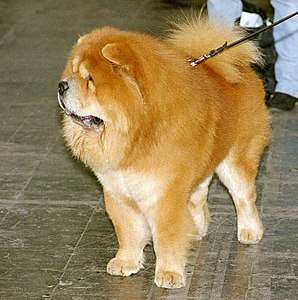 Straight hind legs
Straight hind legs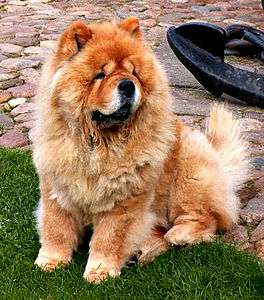 Dense double coat on a male Chow-Chow
Dense double coat on a male Chow-Chow Purple-black tongue in a female Chow-Chow puppy
Purple-black tongue in a female Chow-Chow puppy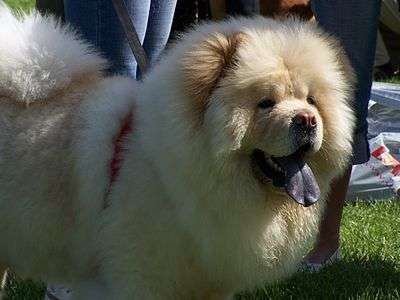 Bluish lips and oral cavity
Bluish lips and oral cavity- Sturdy build, square in profile
- A reddish-brown Chow-Chow
Temperament
Most commonly kept as pets, Chow-Chows tend to display discernment of strangers and can become fiercely protective of their owners and property. The American Kennel Club standards, however, consider an all-too aggressive or all-too timid Chow-Chow to be unacceptable.[7] For that reason, some owners have attributed a cat-like personality to the Chow-Chow.[10][11]
Chow-Chow are not excessively active, meaning that they can be housed in an apartment. However, a Chow-Chow living in an apartment will need daily exercise to prevent restlessness and boredom. Upon realizing that exercise is a daily occurrence, Chow-Chow will tend to be more assertive with owners in anticipation of such activities.
This breed of dog has many strong loyal bonds with friends and family, but the Chow-Chow dog is usually overly protective of one or two main family members.[12] It is in the breed's nature to be quiet and well-behaved, but it is also resistant to training. Chow-Chows become very stubborn and attach to certain individuals as they age. This makes training them when they are puppies crucial, because they gain respect for those who care for them.
To avoid aggression and over-protectiveness as an adult, continuous socialization as early as possible could allow the dog to adjust. When a Chow-Chow reaches adolescence it rejects authority from any owner who failed to earn its admiration. Aggression can be one distinctive behavioural characteristic in this breed, though while some are of an aggressive nature, many are known to be easy-going in nature – sometimes adopting an aloof disposition to individuals other than their owners. Aggression when it does appear is often towards other dogs of the same gender, especially Chows. Due to their strong hunting instincts, it is recommended that these dogs stay fenced, leashed, and away from cats and small dogs. This is why it is crucial that they are socialized early and consistently to act appropriately with strangers. At first, chow-chows are very hesitant in interacting with strangers. However, this problem can be avoided if the owners train the chow-chow at a young age.
Owning a Chow-Chow can raise the cost of homeowners insurance because some companies consider them high-risk dogs.[13] In a study in the Journal of the American Veterinary Medical Association, Chow-Chow were responsible for 8 out of 238 fatalities related to dog bites from 1979 to 1998.[14]
Colours
- The different Chow Chow colours
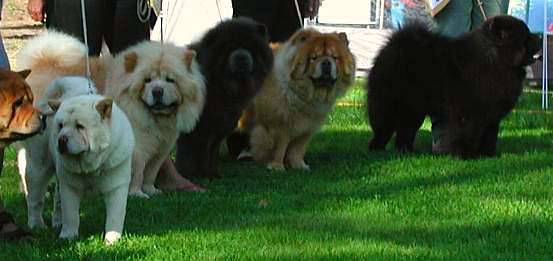 5 Chow-Chows of different coat colors
5 Chow-Chows of different coat colors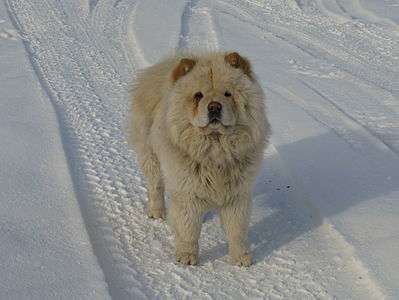 Cream
Cream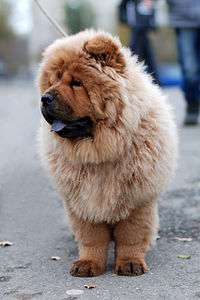 Fawn
Fawn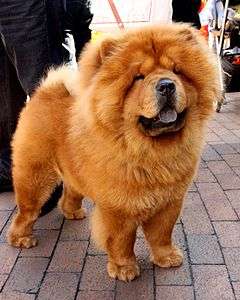 Red
Red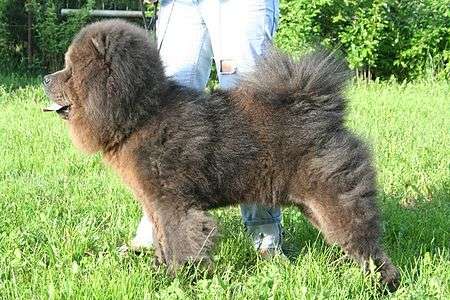 Blue
Blue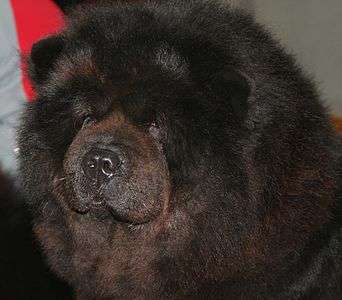 Black
Black
Health
The Chow-Chow can suffer from entropion,[15][16] glaucoma,[17][18] juvenile cataracts,[19] lymphoma,[20] hip dysplasia,[21] diabetes mellitus,[22] canine pemphigus,[23] and gastric cancer.[24] Chow-Chows are a high risk breed for autoimmune disease[25] and are at a predisposition for skin melanoma.[26]
Notable owners

Konrad Lorenz an Austrian zoologist, ethologist, and ornithologist, winner of the 1973 Nobel Prize in Physiology or Medicine[27] who is often regarded as one of the founders of modern ethology, had a Chow-Chow mix named Stasi.[28] He wrote about his dogs in his book King Solomon's Ring.
Georgia O'Keeffe, an American artist, owned at least 6 chow chows in her lifetime. O’Keeffe wrote about her dogs in letters to friends and family, took photographs of them, and sketched them. She was a member of The Chow Chow Club, Inc. and kept various veterinary papers, club notifications, feeding schedules, and correspondence relating to her dogs.[29]
Sigmund Freud had a Chow-Chow named Jo-Fi Ling who attended all of his therapy sessions because he felt that dogs had a special sense that allows them to judge a person's character accurately, and admitted he depended on Jo-Fi for an assessment of a patient's mental state.[30]
U.S. Navy admiral George Dewey acquired a Chow-Chow in Hong Kong in 1898 and named it Bob. Bob rarely left the admiral's side and had the run of the cruiser USS Olympia. Bob died in 1899 due to eating chocolates given to Dewey by well-wishers upon Olympia's arrival in New York City.
Martha Stewart owns several chows, which are frequently seen on Martha's shows.[31] One of them is named Genghis Khan.[32]
President Calvin Coolidge and his wife owned a black Chow named Timmy.[33]
Elvis Presley and his girlfriend Linda Thompson had a Chow-Chow named Getlow.[34]
Vanna Bonta[35][36] has a cream Chow-Chow named Sky, a blue Chow-Chow named Seraph, and a red Chow-Chow named Beowulf, who was immortalized as a fictional dog in the book ‘’Flight’’.
Janet Jackson had a Chow-Chow named Buckwheat.[37]
Italian footballer Mario Balotelli bought his girlfriend two Chow-Chow puppies in the UK.[38]
Grooming
Chow breed will heavily shed their fur in the seasons of spring and autumn, which requires more grooming attention than other seasons. It is important that owners use the correct tool to avoid harming the skin and facilitate grooming. Three kinds of brushes that owners can use on their Chow-Chow are a medium-coarse brush for the larger parts of the body, a slick brush for smaller areas, and a pin brush to maintain the longer strands of hair.[39] Chow-Chows are known to have either short and smooth coat, or a rougher and longer coat. Both create a thick woolly layer, as it gets closer to the skin. They should be brushed four times a week; however shedding seasons may require daily grooming. Also, a spray conditioner can help avoiding breakage and tearing to the thick coat of hair. Lastly, a monthly bath is required to avoid fleas and keep a clean coat of fur.[40]
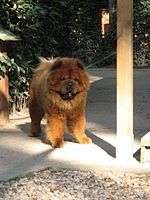 A Chow-Chow with reddish coat.
A Chow-Chow with reddish coat. The Chow-Chow's fur is particularly thick in the neck area, giving it a distinctive ruff or mane appearance.
The Chow-Chow's fur is particularly thick in the neck area, giving it a distinctive ruff or mane appearance.
References
- Wilcox, Charlotte (April 1, 1999). The Chow Chow. Capstone. ISBN 978-0-7368-0159-1.
- "Chow Chow Health & Care Information". AKC. Retrieved February 11, 2017.
- Case, Linda P. (2005). The Dog: Its Behavior, Nutrition, and Health (2nd ed.), p. 23. Blackwell Publishing. ISBN 0-8138-1254-2.
- Larson, G (2012). "Rethinking dog domestication by integrating genetics, archeology, and biogeography". Proc. Natl. Acad. Sci. U.S.A. 109: 8878–83. Bibcode:2012PNAS..109.8878L. doi:10.1073/pnas.1203005109. PMC 3384140. PMID 22615366.
- Calvin W. Schwabe (1979). Unmentionable Cuisine. University of Virginia Press. p. 168. ISBN 978-0-8139-1162-5.
- "Colours and coat types". Chow Chow Club. Retrieved December 16, 2012.
- American Kennel Club (January 1, 2006). "AKC MEET THE BREEDS: Chow Chow". American Kennel Club. American Kennel Club (AKC). Retrieved July 10, 2012.
- CHOWCHOW.at (June 9, 1999). "The FCI Breed Standard". CHOWCHOW.at. CHOWCHOW.at Alle Rechte vorbehalten. Archived from the original on August 11, 2012. Retrieved July 10, 2012.
- Kathy Welsh; Anna Wallace; Vicki DeGruy (2001–2010). "The Truth About Those Black Tongues". Chow Chow Information and Adoption Center. WisconsinChow Chow Rescue. Retrieved July 10, 2012.
- The Chow Chow Club, Inc.'s Welfare Committee (1997). "Chow Chow Temperament Evaluation, Handling & Placement Tips for Animal Shelters". Chow Chow Information and Adoption Center. Wisconsin Chow Chow Rescue. Retrieved July 10, 2012.
- dogtime. "Chow Chow". dogtime. DogTime Media Network. Retrieved July 10, 2012.
- Breed. (n.d.). "Chow Chow. Petsource.org" Archived November 12, 2013, at the Wayback Machine. Retrieved April 3, 2013
- InsuranceAgents.com. "Will Your Canine Affect Your Homeowners Insurance Policy?". InsuranceAgents.com. AgentInsider.com. Archived from the original on October 14, 2012. Retrieved July 10, 2012.
- J. Sacks, Jeffrey; Sinclair, Leslie; Gilchrist, Julie (September 15, 2000). "Vet Med Today: Special Report – "Breeds of dogs involved in fatal human attacks in the United States between 1979 and 1998"" (PDF). JAVMA. 217 (6). Archived from the original (PDF) on April 11, 2015.
- "Chow Chow Welfare: Entropion". www.chowwelfare.com.
- "Entropion in Dogs: Eyelids Folding Inward". VetInfo.
- "Glaucoma @ Animal Eye Care".
- "The Five Most Common Breed Specific Dog Health Problems". VetInfo.
- "Juvenile Cataracts in Dogs". VetInfo.
- "Identifiable Dog Lymphoma Symptoms". VetInfo.
- "Canine Hip Dysplasia". Archived from the original on June 28, 2011. Retrieved July 2, 2011.
- "Diabetes Mellitus". Archived from the original on October 2, 2011. Retrieved July 2, 2011.
- "Canine Pemphigus Treatment with Prednisone". VetInfo.
- "Positional Cloning of the Gene(s) for Gastric Cancer in the Chow Chow". Archived from the original on October 2, 2011. Retrieved July 2, 2011.
- "Establishment of a Genetic Database for Disease Association Studies in the Major Histocompatibility complex for Purebred Dogs". Archived from the original on October 2, 2011. Retrieved July 2, 2011.
- "Canine Skin Melanoma". VetInfo.
- "Konrad Lorenz – Biographical, The Nobel Prize in Physiology or Medicine 1973s". Nobel prize, The Official Web Site of The Nobel Prize. 1973. Retrieved February 11, 2017.
- Konrad Lorenz (1961) King Solomon's Ring Translated by Marjorie Kerr Wilson. Methuen, London. 202 pages. ISBN 0-416-53860-6
- "The Chow Chows". Georgia O'Keeffe Museum. October 17, 2014.
- Coren, Stanley (1997). What Do Dogs Know?. Free Press. p. 128.
- http://amberhero.tripod.com/facts.htm#Martha_Stewart_and_her_chows!
- The Paddock Play Continues – The Daily Wag – Pets – MarthaStewart.com Archived September 24, 2013, at the Wayback Machine. Dailywag.marthastewart.com (September 20, 2013). Retrieved October 23, 2013.
- Atkinson, James (1988). Chow Chows, p. 5. Barron's Educational Series. ISBN 0812039521.
- "ELVIS PRESLEY AND CHOW GETLOW". ChowTales. February 4, 2014.
- "Vanna Bonta is into Genes!".
- "Vanna Bonta Gets Her Dog a Lion Fur-Do - FamousFix". FamousFix.com.
- "Canine Aristocracy". Archived from the original on October 2, 2011. Retrieved July 2, 2011.
- News, Manchester Evening (December 2, 2011). "Meet the other wags: Salford pet shop has a Man United's best friend". men.
- Chow Chow Dog Breed | Information on Chow Chows. (n.d.). Pet Information | Online Resource for Pet Owners | PetWave. Retrieved April 3, 2013, from http://www.petwave.com/Dogs/Dog-Breed-Center/Non-Sporting-Group/Chow-Chow.aspx Archived April 3, 2013, at the Wayback Machine
- Chow Chow Dog Breed Information, Pictures, Characteristics & Facts. (n.d.). "DogTime is the place for dog breeds, pet adoption, pet insurance and expert pet advice". Retrieved April 3, 2013